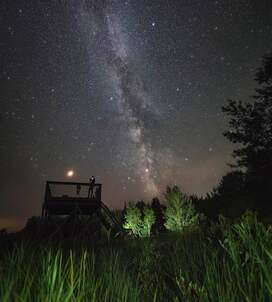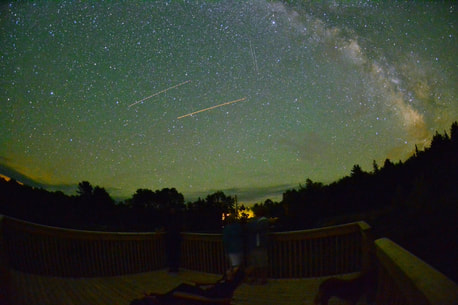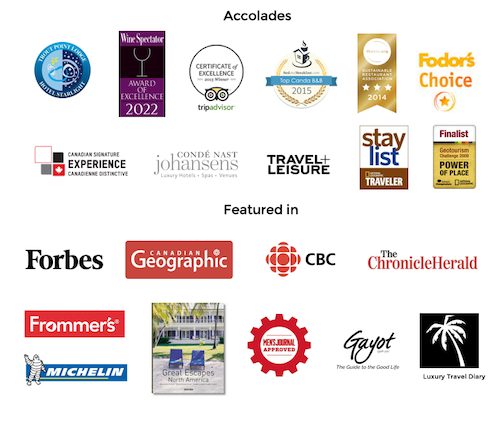|
The Perseid Meteor Shower will be back and visible from July 14th to September 1st this year! It will peak on the mornings of August 11th, 12th and 13th! Though the moon will be 50% illuminated at the time of the Perseids' peak, it will set around midnight, so there will be dark skies until dawn — perfect for meteor hunting!
For avid stargazing guests, New Moon will be on August 4th 2024. On clear nights, we expect to see up to 100 shooting stars per hour with a high probability of fireballs. When the moonlight is low we see the highest rates of meteors/ hour so we are looking forward to this year's Perseids! The Perseids are our favourite and one of the brighter meteor showers each year! Learn more about the Perseids Trout Point Lodge is the world's first Starlight Hotel, certified by UNESCO Starlight Foundation. Our Stargazing Platform is located in a riverside meadow away from the surrounding forest, allowing for nearly unobstructed 360-degree views of the sky. We sit under the darkest skies in North America and together with our platform and knowledgeable guide, offer the ideal conditions to experience the Perseids like never before! |
About the Meteor Shower
The Perseids are considered by many people to be the best meteor shower of the year, and the most popular. With very fast and bright meteors, Perseids frequently leave long "streaks" of light and colour behind them. The Perseids are one of the most plentiful showers (up to 100 meteors seen per hour this year) and occur with warm summer nights.
Perseids are also known for their fireballs. Fireballs are larger explosions of light and colour that can persist longer than an average meteor streak. This is due to the fact that fireballs originate from larger particles of cometary material. Fireballs are also brighter, with apparent magnitudes greater than -3.
People tend to focus on the peak mornings of meteor showers but meteors in annual showers typically last weeks, not days.
Where Do Meteors Come From?
Meteors come from leftover comet particles and bits from broken asteroids. When comets come around the sun, they leave a dusty trail behind them. Every year Earth passes through these debris trails, which allows these particles and bits to collide with our atmosphere and disintegrate to create fiery and colourful streaks in the sky, creating the annual Perseid meteor shower!
The Comet
The pieces of space debris that interact with our atmosphere to create the Perseids originate from comet Swift-Tuttle. This stream of debris is called the Perseid cloud. Swift-Tuttle takes 133 years to orbit the sun once. Most of the particles have been part of the cloud for around a thousand years.
Comet Swift-Tuttle is the largest known object to repeatedly pass by Earth; its nucleus is about 16 miles (26 kilometers) wide. It last passed Earth during its orbit around the sun in 1992, and the next will be in 2126. Earth continues to pass through the its dust and debris every year, creating the annual Perseid meteor shower.
The Radiant
The Perseid shower is named for the constellation Perseus, which is its radiant — the point in the sky from which the Perseids appear to come from. A radiant is the point of origin of the meteor shower, so the Perseid meteors will appear to be traveling away from the constellation Perseus in the night sky. Locating Perseus might therefore help you to see as many meteors as possible. Our guide will point that out when you are here!
The Perseids are considered by many people to be the best meteor shower of the year, and the most popular. With very fast and bright meteors, Perseids frequently leave long "streaks" of light and colour behind them. The Perseids are one of the most plentiful showers (up to 100 meteors seen per hour this year) and occur with warm summer nights.
Perseids are also known for their fireballs. Fireballs are larger explosions of light and colour that can persist longer than an average meteor streak. This is due to the fact that fireballs originate from larger particles of cometary material. Fireballs are also brighter, with apparent magnitudes greater than -3.
People tend to focus on the peak mornings of meteor showers but meteors in annual showers typically last weeks, not days.
Where Do Meteors Come From?
Meteors come from leftover comet particles and bits from broken asteroids. When comets come around the sun, they leave a dusty trail behind them. Every year Earth passes through these debris trails, which allows these particles and bits to collide with our atmosphere and disintegrate to create fiery and colourful streaks in the sky, creating the annual Perseid meteor shower!
The Comet
The pieces of space debris that interact with our atmosphere to create the Perseids originate from comet Swift-Tuttle. This stream of debris is called the Perseid cloud. Swift-Tuttle takes 133 years to orbit the sun once. Most of the particles have been part of the cloud for around a thousand years.
Comet Swift-Tuttle is the largest known object to repeatedly pass by Earth; its nucleus is about 16 miles (26 kilometers) wide. It last passed Earth during its orbit around the sun in 1992, and the next will be in 2126. Earth continues to pass through the its dust and debris every year, creating the annual Perseid meteor shower.
The Radiant
The Perseid shower is named for the constellation Perseus, which is its radiant — the point in the sky from which the Perseids appear to come from. A radiant is the point of origin of the meteor shower, so the Perseid meteors will appear to be traveling away from the constellation Perseus in the night sky. Locating Perseus might therefore help you to see as many meteors as possible. Our guide will point that out when you are here!
Yarmouth & Acadian Shores videos shot on location at Trout Point Lodge!





